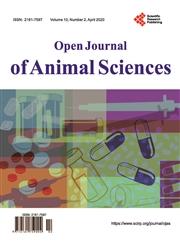Proximate Composition and Fatty Acid Profile of Beef from Arsi, Borana and Harar Cattle Breeds in Oromia National Regional State, Ethiopia
引用次数: 3
Abstract
This study was conducted to determine proximate composition and profile of fatty acid of beef from Arsi, Borana and Harar Cattle breeds in Ethiopia. A total of 39 bulls with three age categories were used for the study. The bulls were purchased from mixed crop livestock system (Arsi and Harar cattle breeds) and Ranch (Borana cattle breed). Complete randomized design was used for the study. Longissimus dorsi muscle was used to evaluate proximate composition and profile of fatty acid. The result of the study indicated that mean of percentage of dry matter, ash, crude fat and crude protein were ranging 22.43 - 24.26, 0.32 - 1.28, 4.32 - 7.88, 17.21 - 22.76, respectively. At age younger than 3 years, Harar bulls contain more crude fat compared to Arsi bulls while the vice versa was true for crude protein. The concentration of polyunsaturated fatty acid (PUFA) was higher than saturated fatty acid (SFA) in the three breeds studied across all age categories. However, significantly higher (P < 0.01) PUFA and lowest (P < 0.05) SFA found in Harar breed whereas the opposite hold true for Arsi bulls. Ratio of n-6: n-3 in the muscle of bulls under the study was ranged from 2.10 to 2.57. Concentration of PUFA and MUF in muscle of the three breeds were significantly affected (P < 0.05) by age. From the study it was concluded that Arsi, Boran and Harar bulls under the three age categories contained more than 3% minimum crude fat that is required to insure palatability of the beef. The higher concentration of PUFA over SFA in all breeds across age categories indicated that the meat from these cattle breeds has less risk hazard to human health. However, a strategy needs to be developed to increase the ratio of n-6: n-3 to the nutritional recommendations by the World Health Organization which is 4:1 to 5:1. Moreover, the cause of the difference in proximate composition and profile of fatty acid between breeds under the study at different age categories needs to be investigated.埃塞俄比亚奥罗米亚民族地区州Arsi、Borana和Harar牛品种牛肉的近似组成和脂肪酸谱
本研究旨在确定埃塞俄比亚Arsi、Borana和Harar牛品种牛肉脂肪酸的近似组成和分布。该研究共使用了39头公牛,分为三个年龄段。公牛是从混合作物牲畜系统(Arsi和Harar牛品种)和牧场(Borana牛品种)购买的。本研究采用完全随机设计。使用背最长肌来评估脂肪酸的近似组成和分布。研究结果表明,干物质、灰分、粗脂肪和粗蛋白质的平均含量分别为22.43 ~ 24.26、0.32 ~ 1.28、4.32 ~ 7.88、17.21 ~ 22.76。在3岁以下的公牛中,Harar公牛的粗脂肪含量高于Arsi公牛,而粗蛋白质含量则相反。多不饱和脂肪酸(PUFA)浓度均高于饱和脂肪酸(SFA)浓度。然而,哈勒尔品种的PUFA极显著高于(P < 0.01), SFA极显著低于(P < 0.05),而阿尔西品种则相反。本研究公牛肌肉中n-6: n-3的比值为2.10 ~ 2.57。随着年龄的增长,3个品种肌肉中PUFA和MUF的浓度均受到显著影响(P < 0.05)。从研究中得出的结论是,三个年龄段的Arsi, Boran和Harar公牛含有超过3%的最低粗脂肪,以确保牛肉的适口性。在不同年龄类别的所有品种中,PUFA浓度高于SFA浓度,这表明这些牛品种的肉对人类健康的风险危害较小。然而,需要制定一项战略,将n-6: n-3的比例提高到世界卫生组织建议的4:1至5:1的水平。此外,在不同年龄类别的研究品种之间,脂肪酸的近似组成和分布差异的原因需要调查。
本文章由计算机程序翻译,如有差异,请以英文原文为准。
求助全文
约1分钟内获得全文
求助全文

 求助内容:
求助内容: 应助结果提醒方式:
应助结果提醒方式:


